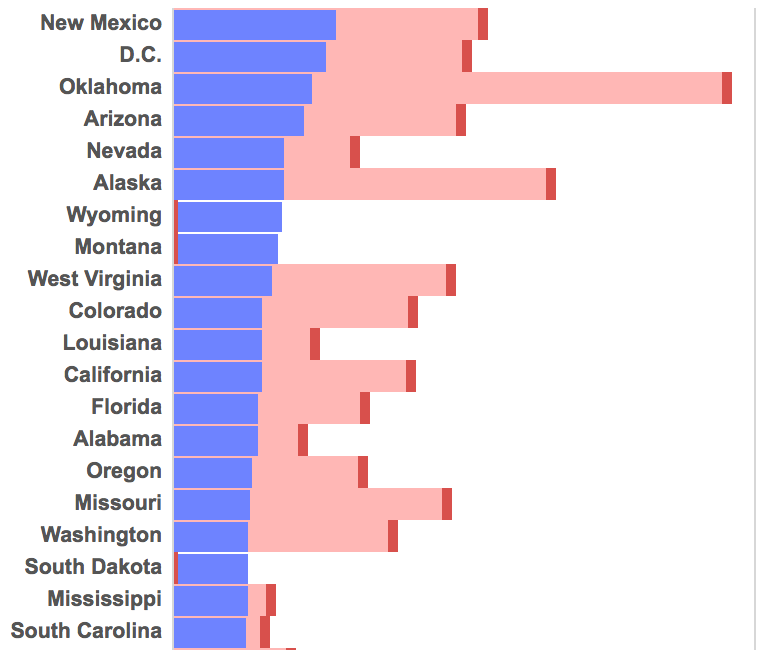As a tangent on doing some research for cities grappling with high-profile killings by police and protesters filling the streets demanding justice, there were found a few more useful resources from this recent report on NBC News from Thursday, April 22nd
Records from eight cities obtained by NBC News show how common it is for police officers to fire their weapons in multiple shootings. Clay Rodery / for NBC News
Most officers never fire their guns. But some kill multiple people — and are still on the job.
In Seattle, one officer's multiple deadly encounters offer a window into this little understood corner of American policing. . .
Policing experts said that officers with multiple shootings may work in high-risk units like SWAT, where they could face violent, unpredictable situations. But because police shootings are so rare, some say that any officer who has amassed a string of shootings should be investigated to assure the public that trigger-happy officers will not be tolerated.
Most officers never fire their weapons.
In
2019, the research-focused nonprofit National Police Foundation released a study of 1,006 police shootings at 47 departments over two years that found that 4 out of 5 officers who fired in those shootings had never discharged their guns before. But experts know little about the ones who fire more than once. . .But aside from the cases that make headlines, researchers have had little data to answer key questions, like why some officers use deadly force more often or how many of them there even are.
The FBI only launched its national
use-of-force collection system in 2019, and the
largest database that tracks police shootings and other deadly encounters doesn’t routinely identify officers.
NBC News requested a decade of records from a dozen law enforcement agencies across the United States with higher than average rates of police killings, according to Mapping Police Violence, an analysis project based on public databases, obituaries and other sources. HERE'S THE SURPRISE:
Records obtained from eight of these departments through public record requests and official databases show more than 150 officers who fired weapons in two or more intentional shootings across eight cities:
Columbus, Ohio
Dallas
Mesa, Arizona
Oklahoma City
Orlando, Florida
Seattle; Spokane, Washington; and
Stockton, California
The data show that in three cities — Mesa, Stockton and Spokane — these officers were linked to more than half of the police shootings from 2008 to 2018.
In Mesa, just five officers fired their guns in 23 incidents over that period.
> Across the eight cities,
NBC News could identify only four shootings linked to these officers that resulted in criminal charges: In Dallas,
one officer was given probation and
another was acquitted; an officer in Oklahoma City
was convicted of murder; and in Orlando, an officer was indicted but
later cleared after a prosecutor
declined to charge him.
> Police officials in Seattle, Mesa and Columbus did not respond to requests for comment about the number of shootings attributed to these officers, . .
>
Also noted in NBC's report, "A study
published three years ago in the Journal of Public Health added another potential factor to the mix:
Researchers studying police shootings in Dallas found that military veterans who had been deployed and later became police officers were three times more likely than other officers to shoot. The researchers weren’t sure why. . .""
--------------------------------------------------------------------------------------------------------------------------------
COMPARE STATES > ARIZONA
State Comparison Tool
This tool is designed to help you hold state policy-makers accountable for police violence. It uses data on police killings that have happened from January 2013 through December 2020. You can use the tool to compare U.S. states to identify which states have the highest levels of police violence. You can also see how police violence disproportionately impacts black people in many states. In doing so, we hope you will be better equipped to hold policy-makers accountable for changing the policies and practices that make their states more likely to threaten black lives.
And after you've explored this tool, click here to learn which police departments bear the most responsibility for this violence.
MAPPING POLICE VIOLENCE
Use this tool to hold Police Chiefs and Mayors accountable for ending police violence in your city. The charts below use data from January, 2013 through December, 2017 to show which police departments are most - and least - likely to kill people. You can also compare police departments operating in jurisdictions with similar levels of crime to show that, even under similar circumstances, some police departments are much more likely to kill people than others. And after you've explored this tool, click here to learn about police violence in your state.
Key Findings:
27% of U.S. police killings between January 2013 - December 2017 were committed by police departments of the 100 largest U.S. cities.
Black people were 39% of people killed by these 100 police departments despite being only 21% of the population in their jurisdictions.
Only 1 of the 100 largest city police departments did not kill anyone from Jan 2013 - Dec 2017 (Irvine, CA).
48% of unarmed people killed by the 100 largest city police departments were black. These police departments killed unarmed black people at a rate 4 times higher than unarmed white people.
Rates of violent crime in cities did not make it any more or less likely for police departments to kill people. For example, Buffalo and Newark police departments had low rates of police violence despite high crime rates while Spokane and Bakersfield had relatively low crime rates and high rates of police violence.
---
More
More





No comments:
Post a Comment